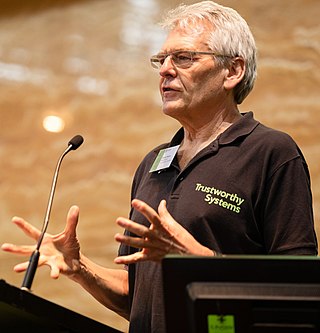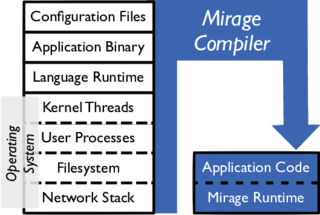Related Research Articles

In computer science, a microkernel is the near-minimum amount of software that can provide the mechanisms needed to implement an operating system (OS). These mechanisms include low-level address space management, thread management, and inter-process communication (IPC).
Mach is a kernel developed at Carnegie Mellon University by Richard Rashid and Avie Tevanian to support operating system research, primarily distributed and parallel computing. Mach is often considered one of the earliest examples of a microkernel. However, not all versions of Mach are microkernels. Mach's derivatives are the basis of the operating system kernel in GNU Hurd and of Apple's XNU kernel used in macOS, iOS, iPadOS, tvOS, and watchOS.
In computing, a virtual machine (VM) is the virtualization or emulation of a computer system. Virtual machines are based on computer architectures and provide the functionality of a physical computer. Their implementations may involve specialized hardware, software, or a combination of the two. Virtual machines differ and are organized by their function, shown here:

In computing, virtual memory, or virtual storage, is a memory management technique that provides an "idealized abstraction of the storage resources that are actually available on a given machine" which "creates the illusion to users of a very large (main) memory".

Memory management is a form of resource management applied to computer memory. The essential requirement of memory management is to provide ways to dynamically allocate portions of memory to programs at their request, and free it for reuse when no longer needed. This is critical to any advanced computer system where more than a single process might be underway at any time.

Exokernel is an operating system kernel developed by the MIT Parallel and Distributed Operating Systems group, and also a class of similar operating systems.
L4 is a family of second-generation microkernels, used to implement a variety of types of operating systems (OS), though mostly for Unix-like, Portable Operating System Interface (POSIX) compliant types.

A memory management unit (MMU), sometimes called paged memory management unit (PMMU), is a computer hardware unit that examines all memory references on the memory bus, translating these requests, known as virtual memory addresses, into physical addresses in main memory.
Memory protection is a way to control memory access rights on a computer, and is a part of most modern instruction set architectures and operating systems. The main purpose of memory protection is to prevent a process from accessing memory that has not been allocated to it. This prevents a bug or malware within a process from affecting other processes, or the operating system itself. Protection may encompass all accesses to a specified area of memory, write accesses, or attempts to execute the contents of the area. An attempt to access unauthorized memory results in a hardware fault, e.g., a segmentation fault, storage violation exception, generally causing abnormal termination of the offending process. Memory protection for computer security includes additional techniques such as address space layout randomization and executable-space protection.
Cache only memory architecture (COMA) is a computer memory organization for use in multiprocessors in which the local memories at each node are used as cache. This is in contrast to using the local memories as actual main memory, as in NUMA organizations.

Peter James Denning is an American computer scientist and writer. He is best known for pioneering work in virtual memory, especially for inventing the working-set model for program behavior, which addressed thrashing in operating systems and became the reference standard for all memory management policies. He is also known for his works on principles of operating systems, operational analysis of queueing network systems, design and implementation of CSNET, the ACM digital library, and codifying the great principles of computing. He has written numerous influential articles and books, including an overview of fundamental computer science principles, computational thinking, and his thoughts on innovation as a set of learnable practices.
A hypervisor, also known as a virtual machine monitor (VMM) or virtualizer, is a type of computer software, firmware or hardware that creates and runs virtual machines. A computer on which a hypervisor runs one or more virtual machines is called a host machine, and each virtual machine is called a guest machine. The hypervisor presents the guest operating systems with a virtual operating platform and manages the execution of the guest operating systems. Unlike an emulator, the guest executes most instructions on the native hardware. Multiple instances of a variety of operating systems may share the virtualized hardware resources: for example, Linux, Windows, and macOS instances can all run on a single physical x86 machine. This contrasts with operating-system–level virtualization, where all instances must share a single kernel, though the guest operating systems can differ in user space, such as different Linux distributions with the same kernel.
Memory segmentation is an operating system memory management technique of dividing a computer's primary memory into segments or sections. In a computer system using segmentation, a reference to a memory location includes a value that identifies a segment and an offset within that segment. Segments or sections are also used in object files of compiled programs when they are linked together into a program image and when the image is loaded into memory.

Jochen Liedtke was a German computer scientist, noted for his work on microkernel operating systems, especially in creating the L4 microkernel family.
In computer science, capability-based addressing is a scheme used by some computers to control access to memory as an efficient implementation of capability-based security. Under a capability-based addressing scheme, pointers are replaced by protected objects which specify both a location in memory, along with access rights which define the set of operations which can be carried out on the memory location. Capabilities can only be created or modified through the use of privileged instructions which may be executed only by either the kernel or some other privileged process authorised to do so. Thus, a kernel can limit application code and other subsystems access to the minimum necessary portions of memory, without the need to use separate address spaces and therefore require a context switch when an access occurs.

Gernot Heiser is a Scientia Professor and the John Lions Chair for operating systems at UNSW Sydney, where he leads the Trustworthy Systems group (TS).

The kernel is a computer program at the core of a computer's operating system and generally has complete control over everything in the system. The kernel is also responsible for preventing and mitigating conflicts between different processes. It is the portion of the operating system code that is always resident in memory and facilitates interactions between hardware and software components. A full kernel controls all hardware resources via device drivers, arbitrates conflicts between processes concerning such resources, and optimizes the utilization of common resources e.g. CPU & cache usage, file systems, and network sockets. On most systems, the kernel is one of the first programs loaded on startup. It handles the rest of startup as well as memory, peripherals, and input/output (I/O) requests from software, translating them into data-processing instructions for the central processing unit.
Open Kernel Labs is a privately owned company that develops microkernel-based hypervisors and operating systems for embedded systems. The company was founded in 2006 by Steve Subar and Gernot Heiser as a spinout from NICTA. It was headquartered in Chicago, while research and development was located in Sydney, Australia. The company was acquired by General Dynamics in September 2012.

In computer science, shared memory is memory that may be simultaneously accessed by multiple programs with an intent to provide communication among them or avoid redundant copies. Shared memory is an efficient means of passing data between programs. Depending on context, programs may run on a single processor or on multiple separate processors.

A unikernel is a computer program statically linked with the operating system code on which it depends. Unikernels are built with a specialized compiler that identifies the operating system services that a program uses and links it with one or more library operating systems that provide them. Such a program requires no separate operating system and can run instead as the guest of a hypervisor.
References
- ↑ Eric J. Koldinger; Jeffrey S. Chase; Susan J. Eggers (September 1992). "Architecture support for single address space operating systems". ACM SIGPLAN Notices . 27 (9): 175–186. doi:10.1145/143371.143508.
- ↑ Tim Wilkinson; Kevin Murray; Stephen Russell; Gernot Heiser; Jochen Liedt (13 November 1995). "Single Address Space Operating Systems" (PDF). University of New South Wales. Section 2: "Memory Protection". CiteSeerX 10.1.1.13.7042 .
- ↑ Jeffrey S. Chase; Henry M. Levy; Michael J. Feeley; Edward D. Lazowska (November 1994). "Sharing and protection in a single-address-space operating system" (PDF). ACM Transactions on Computer Systems . 12 (4): 271–307. CiteSeerX 10.1.1.127.7313 . doi:10.1145/195792.195795.
- ↑ Watson, Robert N. M.; Neumann, Peter G.; Woodruff, Jonathan; Anderson, Jonathan; Anderson, Ross; Dave, Nirav; Laurie, Ben; Moore, Simon W.; Murdoch, Steven J.; Paeps, Philip; Roe, Michael; Saidi, Hassen (3 March 2012). "CHERI: a research platform deconflating hardware virtualization and protection" (PDF). Unpublished workshop paper for RESoLVE’12, March 3, 2012, London, UK. SRI International Computer Science Laboratory.
- ↑ Michael Golm; Meik Felser; Christian Wawersich; Jürgen Kleinöder. "The JX Operating System" (PDF).
- ↑ Kevin Boos, Namitha Liyanage, Ramla Ijaz, and Lin Zhong. "Theseus: an Experiment in Operating System Structure and State Management". 2020.
- ↑ "Torsion Operating System". quote: "Torsion ... a single address space multitasking operating system with transparent data persistence."